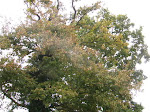
The green manure we used in some beds back in late autumn 2007 consisted of a rye, vetch and tetraploid Italian rye grass mixture. Suitable for organic gardening, it was, according to the packet, "fast and easy to grow". In addition, there was the promise it would add nutrients and improve soil fertility and structure. You simply dig it in after 40 - 90 days when it is supposed to be 23 cm tall. Taking the advice by Dan Pearson (Observer Magazine, 18 November 2007), we covered our green manure experimental beds with fleece to prevent pigeons decimating the seedlings and to keep the warmth in the ground.
On a regular basis, we've taken a peep under the fleece. We're not sure what we're meant to be looking for. I've pulled back the fleece covering one of the beds and it is possible that those green blades may well be our desired end result. If so, they are not yet 23 cm tall. And why is most of the soil bare? Back to Dan:
"The secret with any green manure crop is to trench it back into the soil at its most bulky, and you have to watch for the point at which the plants start to initiate flower. ... As soon as this happens, a subtle but significant shift in the plant occurs where the bulk of foliage, produced to fuel seed production, is converted into the flowering growth. You will have wasted considerable bulk if you miss this moment."
We will soon need to use the bean beds so we have decided to cut our losses here and dig the what-could-well-be-green-manure into the soil. That's what I did on a rainy 13 March. Surprisingly, the soil was virtually weed-free, feeling and looking very fertile. We'll leave the fleece on the other beds for the moment.

